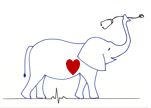Radiology Quiz
1. Based on the “clock-face” analogy, a bump at the 12 to 1 o’clock position on a DV view of the heart most likely indicates enlargement of which structure?
a. Main pulmonary artery
b. Aortic arch
c. Left atrium
d. Left atrial appendage
Answer
2. Which of the following radiographic findings is more common in cats with congestive heart failure than dogs?
a. Pleural effusion
b. Pulmonary edema
c. Ascites
d. Pneumothorax
Answer
3. Which of the following is usually an acquired, rather than congenital issue in dogs?
a. Pectus Excavatum
b. Pulmonic Stenosis
c. Peritoneopericardial diaphragmatic hernia
d. Pulmonary vein distention due to left-sided congestive heart failure
Answer
4. What is the most common distribution of cardiogenic pulmonary edema?
a. The perihilar and caudodorsal regions
b. The right middle lung lobe
c. The left middle lung lobe
d. The cranial lung lobes
Answer
5. Which of the following does not correctly match its given definition?
a. Cardiac Apex – The region where the interventricular septum and left and right free walls intersect, located close to the sternum on a lateral radiograph.
b. Cardiac Base – The most dorsal region of the heart, where the great vessels arise.
c. Cardiac Waist- The narrowest segment of the cardiac silhouette, closest to the sternum on a lateral radiograph.
d. Vertebral Heart Scale (VHS) – a numerical measure of cardiac size based on a long and short axis measure from the lateral radiographic projection, compared to vertebral body length.
Answer
6. This right lateral radiograph is from a cat that was admitted to the hospital with dyspnea. What is your radiographic findings and/or conclusions?

a. The cat has pectus excavatum and surgery should be considered
b. The cat has normal findings on the thoracic radiographs; upper airway obstruction should be considered
c. The cat has pneumonia and antibiotics should be administered
d. The cat has cardiac enlargement, pleural effusion, and pulmonary infiltrates that are compatible with congestive heart failure
Answer
7. An English Bulldog is undergoing thoracic radiographs to look for megaesophagus. The following right lateral radiograph is obtained. What are your thoughts?

a. This dog has megaesophagus, and an upright feeding chair should be recommended.
b. This dog has extra mediastinal fat, and megaesophagus is not identified.
c. This dog has pulmonary edema in the cranial lung lobes, likely secondary to aspiration pneumonia.
d. This dog has a large volume pleural effusion, and a thoracentesis should be performed immediately.
Answer
8. Which of the following statements is correct relative to pulmonary arteries and veins on thoracic radiographs?
a. If both the pulmonary arteries and vein are smaller than normal, then a congenital cardiac defect like patent ductus arteriosus should be considered
b. If the pulmonary vein is enlarged, then right-sided congestive heart failure is likely present
c. If the pulmonary artery is enlarged, then the animal may have pulmonary hypertension
d. If both the pulmonary artery and the pulmonary vein are enlarged, then the animal may have hypovolemic shock or Addison’s disease
Answer
